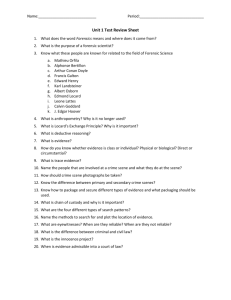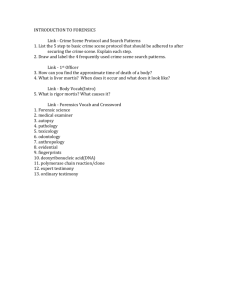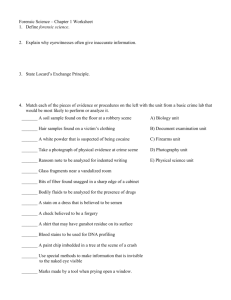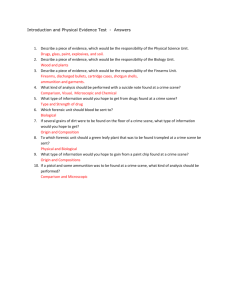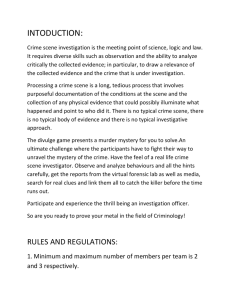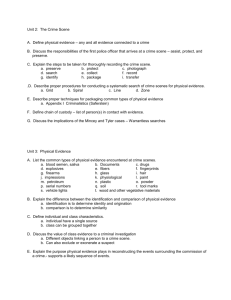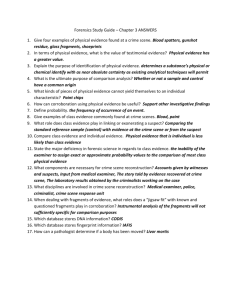crime scene investigation & evidence collection
advertisement
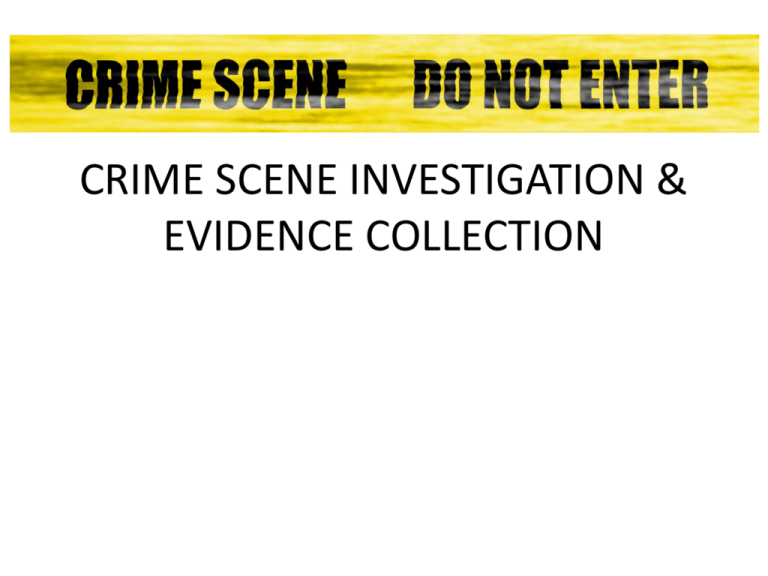
CRIME SCENE INVESTIGATION & EVIDENCE COLLECTION CSI team and Crime lab The Seven S’s of Cime Scene Investigation Responsibilities of first officer 1. Obtain medical assistance for anyone in need 2. Arrest any perpetrators 3. Exclude all unauthorized personnel 4. Isolate the area 5. Determine the boundaries of crime scene 6. Entry and exit points of perpetrator 7. Initial walk through 8. Develop strategy for examining and documenting crime scene 9. Determining primary and possible secondary crime scenes 10. Document and photograph obvious evidence Crime Scene Search Patterns photographs • Objects must NOT be removed until photographed from all angles • If anything removed it should be noted and NOT be reintroduced • Include photos of adjacent areas, close-ups of victim’s relative position in the scene and injuries • If size is significant, a point of reference should be included in the photo • Videotaping and narrating the crime scene can also be done Scaled sketch of the crime scene http://vimeo.com/45223797 The Frye Standard Frye v. United States (1923) (polygraph test questioned) The Frye Standard Practical application: Evidence Direct Evidence Evidence Circumstantial (Indirect) Evidence Locard’s Exchange Principle • Established by Dr. Edmond Locard Physical evidence Biological evidence • Control Sample: • Standard/reference sample: • Substrate control: Packaging evidence 1. 2. 3. 4. Create a clean paper and place evidence in the X position Fold in the left and right sides, and then fold in the top and bottom Put the bindle into a plastic or paper evidence bag affixing a seal over the opening Write your name on the seal Chain of Custody – Provides documentation of every person who has come into contact with the evidence – A paper trail – Demonstrates to the courts that the evidence that is being presented at trial is free of contamination, alteration, or substitution Bagging the evidence 1. 2. 3. Bag the evidence Add identification Seal it Sign it across the sealed edge Sign over to a lab technician Open bag on non-sealed edge Return items to the evidence bag Seal evidence bag in another bag Sign the evidence log • Never package wet evidence while wet • Blood stained material should NOT be stored in airtight containers due to mold potential. Paper bags or wrapping paper used. • Air dry clothes and place in individual separate bags • Charred debris from fire is sealed in airtight containers • Facts result from collected evidence processed by the forensic lab • Lead detective aims to see how facts fit into the crime scenario • Lab results can show the reliability of witness accounts, establish identity of victim or suspects, show suspects innocence or link them with the crime. Crime scene reconstruction Crime scene reconstruction involves: Staging When lab results don’t match up with the testimony of witnesses Common examples:
